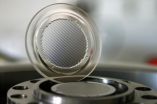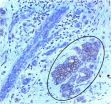98.6 degrees Fahrenheit ideal temperature for keeping fungi away and food at bay
2010-12-23
(Press-News.org) December 21, 2010 — (BRONX, NY) — Two researchers at Albert Einstein College of Medicine of Yeshiva University have found that our 98.6° F (37° C) body temperature strikes a perfect balance: warm enough to ward off fungal infection but not so hot that we need to eat nonstop to maintain our metabolism.
"One of the mysteries about humans and other advanced mammals has been why they are so hot compared with other animals," said study co—author Arturo Casadevall, M.D., Ph.D., professor and chair of microbiology & immunology at Einstein. "This study helps to explain why mammalian temperatures are all around 37° C." Dr. Casadevall also holds the Leo and Julia Forchheimer Chair in Microbiology and Immunology.
The research builds upon earlier work by Dr. Casadevall showing that the number of fungal species that can thrive and therefore infect an animal declines by 6 percent for every 1° C rise in temperature. This means that tens of thousands of fungal species infect reptiles, amphibians and other cold—blooded animals, but only a few hundred harm mammals. Such protection against fungal infection, Dr. Casadevall has speculated, could have been crucial for the triumph of mammals following the age of dinosaurs.
In this study, Dr. Casadevall and his Einstein coauthor, Aviv Bergman, Ph.D., professor and founding chair of systems & computational biology, devised a mathematical model that analyzed the benefits gained by body temperatures that protect against fungi versus the costs (in terms of extra food consumption) required to maintain body temperatures between 30° and 40° C. The optimal temperature for maximizing benefits while minimizing costs was found to be 36.7° C, which closely approximates normal body temperature.
"This study is a good example of how mammalian evolution has been driven by both external biological factors and internal physiological constraints," said Dr. Bergman.
The paper, "Mammalian Endothermy Optimally Restricts Fungi and Metabolic Costs," appeared in the November 9 edition of mBio.
INFORMATION:
About Albert Einstein College of Medicine of Yeshiva University
Albert Einstein College of Medicine of Yeshiva University is one of the nation's premier centers for research, medical education and clinical investigation. During the 2009-2010 academic year, Einstein is home to 722 M.D. students, 243 Ph.D. students, 128 students in the combined M.D./Ph.D. program, and approximately 350 postdoctoral research fellows. The College of Medicine has 2,775 fulltime faculty members located on the main campus and at its clinical affiliates. In 2009, Einstein received more than $155 million in support from the NIH. This includes the funding of major research centers at Einstein in diabetes, cancer, liver disease, and AIDS. Other areas where the College of Medicine is concentrating its efforts include developmental brain research, neuroscience, cardiac disease, and initiatives to reduce and eliminate ethnic and racial health disparities. Through its extensive affiliation network involving five medical centers in the Bronx, Manhattan and Long Island - which includes Montefiore Medical Center, The University Hospital and Academic Medical Center for Einstein - the College of Medicine runs one of the largest post-graduate medical training programs in the United States, offering approximately 150 residency programs to more than 2,500 physicians in training. For more information, please visit www.einstein.yu.edu
ELSE PRESS RELEASES FROM THIS DATE:
2010-12-23
Projectors are getting smaller and smaller. Now that pictures are available in digital format almost everywhere, we need projectors to beam giant photos and films onto walls. Projectors contain lenses that spread the light from the pixelated source in such a way as to illuminate the image area evenly. Until now, this was done using complicated arrays of lenses placed one behind the other. Recently, the same effect has been achieved using flat lens arrays made up of thousands of identical microlenses. This kind of array takes up much less space and does not need to be painstakingly ...
2010-12-23
The only way to learn if your water source has hexavalent chromium is to check with your public water supplier and request a water quality report, said NJIT Professor Taha Marhaba, a civil/environmental engineer. Most municipal or city engineers should be able to provide such a report upon request. Additional information specifically about hexavalent chromium levels may also be available.
"In general, hexavalent chromium can be found in either surface or groundwater sources and its source can be either natural or man-made industrial operations that have used chromium," ...
2010-12-23
About 50 miles from Bethlehem, a drilling project is determining the climate and earthquake activity of the Holy Land. Scientists from eight nations are examining the ground below the Dead Sea, by placing a borehole in this deepest basin in the world. The International Continental Scientific Drilling Program ICDP brings together research teams from Israel, Japan, Norway, Switzerland, the USA and Germany. Particularly noteworthy: Researchers from Jordan and Palestine are also involved.
Scientists and technicians of the GFZ German Research Centre for Geosciences have now ...
2010-12-23
JACKSONVILLE, Fla. — Neuroscientists had assumed that a mutation in the progranulin gene, which makes the progranulin protein and supports brain neurons, was sufficient to produce a kind of dementia known as frontotemporal lobar degeneration (FTLD). But now an international team of scientists led by researchers at Mayo Clinic's campus in Florida have found another genetic factor they say appears to protect against the disorder in progranulin mutation carriers.
In an article published in the Dec. 22, 2010, issue of Neurology, the medical journal of the American Academy ...
2010-12-23
JUPITER, FL, December 22, 2010 – A scientist from the Florida campus of The Scripps Research Institute has discovered a molecular switch that controls the synthesis of ribosomes. Ribosomes are the large machineries inside all living cells that produce proteins, the basic working units of any cell. These new findings offer a novel target for potential treatments for a range of diseases, including cancer.
The study is published in the December 24, 2010 edition of the Journal of Molecular Biology.
The study identified the molecular switch, essentially formed by a small ...
2010-12-23
AURORA, Colo. (Dec. 22, 2010)—A class of drugs thought to kill cancer cells may in fact block "cross talk" between the cancer cell and normal immune cells, resulting in reduced cancer growth and spread—a discovery that could significantly alter the way cancer drugs are evaluated in the future.
Researchers at the University of Colorado Cancer Center demonstrated the discovery in bladder cancer, the fifth most common cancer in the United States. Bladder cancer will kill about 14,000 Americans this year, most of whom will die as a result of the disease's spread to other ...
2010-12-23
University Park, Pa. -- A computer program that automatically analyzes mounds of satellite images and other data could help climate scientists keep track of complex, constantly changing environmental conditions, according to an international team of researchers.
"All of the data and information that is continually collected by satellites and sensors can cause tons of problems for scientists, who simply don't have the time to analyze every pixel of every satellite image," said James Wang, professor of information sciences and technology, Penn State. "Our goal has been ...
2010-12-23
WASHINGTON, D.C., December 22, 2010 -- What can scientists learn from watching a group of people sitting around, chatting, playing movies, reading, and happily making new friends? Quite a lot, says University of Melbourne, Australia acoustician Adam Vogel, who carefully observed this sort of group in a fatigue management study he and his colleagues describe this month in The Journal of the Acoustical Society of America.
Their report shows the effects of sustained wakefulness on speech and describes a novel method to acoustically analyze the effects of fatigue on the central ...
2010-12-23
Gaithersburg, MD – On December 14-15, 2010, the U.S. Food and Drug Administration (FDA) convened an Advisory Panel to discuss several scientific issues that may affect the regulation of dental amalgam. At the conclusion of the hearing, the Panel voted to recommend that the FDA conduct further review of the material's safety.
The meeting comes on the heels of a July 2009 Final Rule (http://bit.ly/FDA2009FinalRule) from the FDA that reclassified dental mercury from a class I device to a class II device and designated special controls for dental amalgam, mercury and amalgam ...
2010-12-23
PHILADELPHIA – Overexpression or hyperactivation of ErbB cell-surface receptors drives the growth of many breast cancers. Drugs, like Herceptin, that block the receptors' signals halt tumor progression in some patients. However, not all patients' tumors respond, with some becoming resistant over time. Different drugs that interfere with other steps in the signaling pathway may improve the response of patients, yet little is known about these molecules.
Now, Marcelo G. Kazanietz, PhD, professor of Pharmacology at the University of Pennsylvania School of Medicine and colleagues, ...
LAST 30 PRESS RELEASES:
[Press-News.org] 98.6 degrees Fahrenheit ideal temperature for keeping fungi away and food at bay


